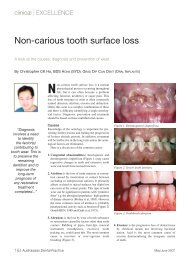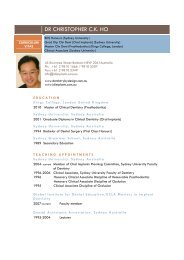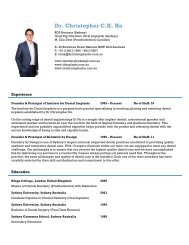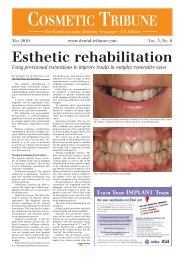Peri-implantitis - Institute for Dental Implants
Peri-implantitis - Institute for Dental Implants
Peri-implantitis - Institute for Dental Implants
Create successful ePaper yourself
Turn your PDF publications into a flip-book with our unique Google optimized e-Paper software.
clinical | EXCELLENCE<br />
Figure 7. Poor design of fixed prosthesis with buccal flange. This does not allow cleaning of the tissue fitting surface of the bridge<br />
with subsequent soft tissue inflammation evident from food trapping.<br />
Figure 8. All-ceramic fixed implant supported bridge with convex tissue fitting surface allowing cleansability by the patient with supefloss,<br />
waterpick or interdental aids.<br />
<strong>Implants</strong> in patients<br />
with periodontitis<br />
A number of studies have confirmed that<br />
patients with a history of periodontitis<br />
may yield lower success rates than<br />
patients without a history of periodontitis<br />
(Karoussis et al. 2004, Roos-Jansaker et<br />
al. 2006).<br />
Aggressive periodontitis<br />
So far, there are a few case reports <strong>for</strong><br />
implant therapy in aggressive periodontitis<br />
patients. The evidence is not<br />
conclusive and some reported failure and<br />
some reported success (Fardal et al. 1999,<br />
Malmstrom et al. 1990, Yalcin et al. 2001,<br />
Wu & Chee 2007).<br />
A study comparing implant success<br />
rates in aggressive periodontitis and<br />
chronic periodontitis patients showed that<br />
3-year implant success rate is slightly<br />
lower in aggressive periodontitis patients,<br />
but still well above 95% with strict periodontal<br />
maintenance regime (Mengel &<br />
Flores-de-Jacoby 2005).<br />
Refractory periodontitis<br />
For refractory periodontitis, if the periodontal<br />
infections are not under control,<br />
implant therapy should be delayed.<br />
Figure 9. <strong>Peri</strong>odontitis (left) vs peri-<strong>implantitis</strong> (right). Note there is no periodontal ligament<br />
attachment with implants (Image courtesy of Astratech).<br />
Maintenance and recall<br />
After successful periodontal and implant<br />
therapy, the patient should be offered<br />
an individually tailored maintenance care<br />
program. It is important to assess mobility,<br />
probing depth, bleeding on probing<br />
and suppuration during a recall visit.<br />
Radiographic and microbiological parameters<br />
are to be added, depending on the<br />
primary clinical findings. In addition, the<br />
occlusion of the suprastructures should<br />
not be overlooked.<br />
In the treatment of peri-<strong>implantitis</strong>,<br />
only limited scientific evidence is available<br />
to recommend any specific treatment<br />
modality. Most studies lack controls<br />
and randomization and are often<br />
handicapped by a small sample size.<br />
There are also limited reports on microbiological<br />
changes and histological changes<br />
following treatment.<br />
Nevertheless, a systematic approach <strong>for</strong><br />
monitoring tissues around implants in the<br />
prevention and treatment of peri-implant<br />
142 Australasian <strong>Dental</strong> Practice January/February 2011











